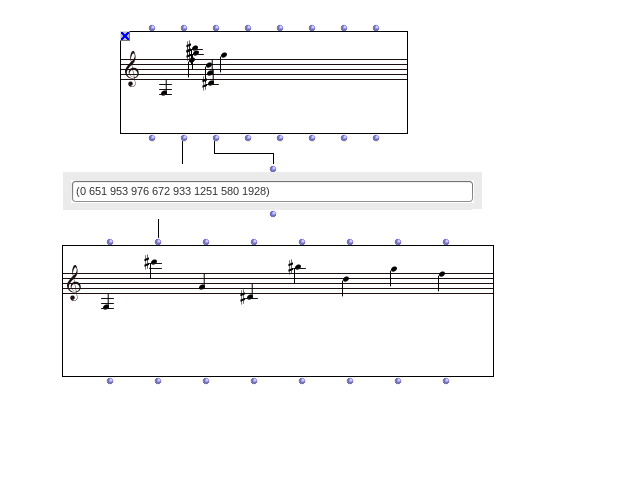Hi,
I am trying to quantify a chord-seq into a voice object, but I can not get the same auditive results between the two.
Can someone help me?
Thank you in advance,
Dimitris
Chord-seq to voice building .omp (21.8 KB)

Hi,
I am trying to quantify a chord-seq into a voice object, but I can not get the same auditive results between the two.
Can someone help me?
Thank you in advance,
Dimitris
Chord-seq to voice building .omp (21.8 KB)
Dear Dimitris,
Many to say here:
Durations are the blue lines and since they overlap you will have a different rhythm.
Instead, use the true-durations method (2) which will return the ocrrect durations according to the onsets.
Now in (3) you just connected the CHORD-SEQ to a VOICE which will use the OM preferences (quantification tab) parameters which by default are:
Notice the Dela Chords parameter which is at 100ms meaning that all duration interval falling in this range will be considered as a chord.
So you can refine these parameters like in (4) using:
In either case you will not have the same sounding performance, since VOICE is monophonic, and you will not have the sound overlapping as in the chord-seq. The goal in quantification is to have the closest thing to the raw material of a chord-seq
The patch:
chord-seq to voice building 2.omp (23.8 KB)
Hope this helps.
Best
K
PS: Note in the upcoming version 7.7 we will have grace notes quantified. So this also can help being closest to the original raw rhythmic material. Coming soon.
Dear Karim,
as always great!
Thank you so much!!
Dimitris
One question more,
why the order of the notes of the lmidic is different than the chord seq view?
The pitches sound in a different order. Is it an illusion because of the fast note sequence?
Thank you!
Dimitris
Dear Dimitris,
Very good observation and perception.
The reason is that in you initial patch:
You are creating a sequence of notes with random onsets.
The random onsets are not sorted in a correct order (ie progressively):
Here you can see that the correct ordered pitch sequence according to their onsets are displayed
The onset in your initial chord-seq:

as you can see they are not sorted in an ascending order
You have the E which appears (and played before the high C#) although it appears to have the highest onset. This should not happen in principle.
The trick to get things right, is first to embed your random duration process in a red patch, and put it in eval-once mode like shown here:
The reason is that you are evaluating twice the output of random and therefore, onsets and durations are decorrelated (generated by two different set of values). As you can see now, all your durations are not overlapping since they coincide with their onsets. And the notes are ordered.
Here is the patch:
chord-seq to voice building 11.omp (18.7 KB)
Best
K
Thank you a lot Karim!
Always great to get more tips on the way that things work!
Many greetings,
Dimitris